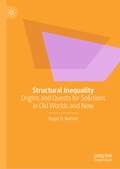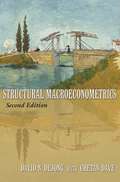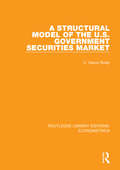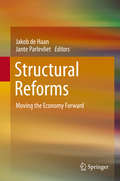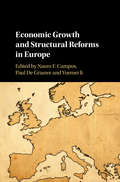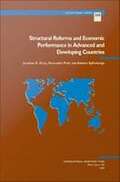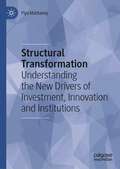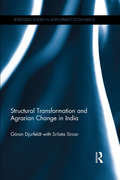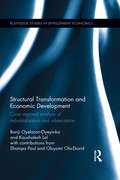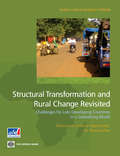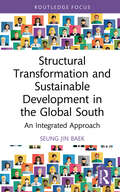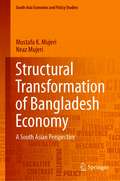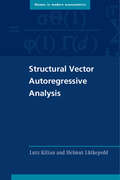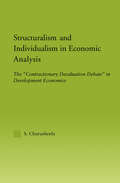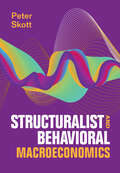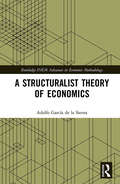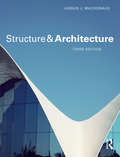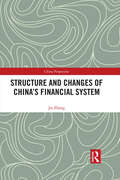- Table View
- List View
Structural Holes: The Social Structure of Competition
by Ronald S. BurtRonald Burt describes the social structural theory of competition that has developed through the last two decades. The contrast between perfect competition and monopoly is replaced with a network model of competition. The basic element in this account is the structural hole: a gap between two individuals with complementary resources or information. When the two are connected through a third individual as entrepreneur, the gap is filled, creating important advantages for the entrepreneur. Competitive advantage is a matter of access to structural holes in relation to market transactions.
Structural Inequality: Origins and Quests for Solutions in Old Worlds and New
by Roger D. NortonInequality stirs passions across the globe today, figures prominently in political discourse, generates fervid debate and popular protest, and is the theme of widely read scholarly publications. This book contributes to the burgeoning global dialogues and literature on economic inequality in a new way, identifying and addressing what may be called bedrock types of inequality whose origins are rooted in the history and culture of each country. These kinds of inequality strongly influence income distributions by strata, can be resistant to change, and require solutions beyond fiscal tax and expenditure policies. And it places the findings firmly in the realm of the relevant studies on the topics covered. The countries analyzed include South Korea, Mexico, El Salvador, Honduras, Peru, Estonia, Pakistan, Bangladesh, Nigeria, and Yemen.
Structural Macroeconometrics: Second Edition
by David N. DeJong Chetan DaveThe revised edition of the essential resource on macroeconometricsStructural Macroeconometrics provides a thorough overview and in-depth exploration of methodologies, models, and techniques used to analyze forces shaping national economies. In this thoroughly revised second edition, David DeJong and Chetan Dave emphasize time series econometrics and unite theoretical and empirical research, while taking into account important new advances in the field.The authors detail strategies for solving dynamic structural models and present the full range of methods for characterizing and evaluating empirical implications, including calibration exercises, method-of-moment procedures, and likelihood-based procedures, both classical and Bayesian. The authors look at recent strides that have been made to enhance numerical efficiency, consider the expanded applicability of dynamic factor models, and examine the use of alternative assumptions involving learning and rational inattention on the part of decision makers. The treatment of methodologies for obtaining nonlinear model representations has been expanded, and linear and nonlinear model representations are integrated throughout the text. The book offers a rich array of implementation algorithms, sample empirical applications, and supporting computer code.Structural Macroeconometrics is the ideal textbook for graduate students seeking an introduction to macroeconomics and econometrics, and for advanced students pursuing applied research in macroeconomics. The book's historical perspective, along with its broad presentation of alternative methodologies, makes it an indispensable resource for academics and professionals.
A Structural Model of the U.S. Government Securities Market (Routledge Library Editions: Econometrics #14)
by V. Vance RoleyOriginally published in 1979. This study focuses primarily on the development of a structural model for the U. S. Government securities market, ie. the specification and estimation of the demands for disaggregated maturity classes of U.S. Government securities by the individual investor groups participating in the market. A particularly important issue addressed involves the extent of the substitution relationship among different maturity classes of U.S. Government securities.
Structural Packaging: Design Your Own Boxes And 3d Forms
by Paul JacksonUnlike other packaging titles, which simply provide templates to copy, this book enables designers of all packaging types to create 3-D packaging forms that are specific to their needs rather than based on an existing design. It teaches a simple ‘net’ construction system – a one-piece 2-D configuration of card seen when a 3-D package is opened out and flattened – which enables the designer to create a huge number of very strong 3-D packaging forms that are both practical and imaginative. Each chapter concludes with photographs and net drawings of 6–10 creative examples of packaging designs made using the principles outlined in the preceding chapter. Structural Packaging gives the reader an understanding of the underlying principles of packaging construction and the technical knowledge and confidence to develop a greater number of their own unusual and innovative designs than any comparable book.Download the crease diagrams from the book for free at www.laurenceking.com
Structural Packaging: Design your own Boxes, 3D Forms
by Paul JacksonUnlike other packaging titles, which simply provide templates to copy, this book enables designers of all packaging types to create 3-D packaging forms that are specific to their needs rather than based on an existing design. It teaches a simple ‘net’ construction system – a one-piece 2-D configuration of card seen when a 3-D package is opened out and flattened – which enables the designer to create a huge number of very strong 3-D packaging forms that are both practical and imaginative. Each chapter concludes with photographs and net drawings of 6–10 creative examples of packaging designs made using the principles outlined in the preceding chapter. Structural Packaging gives the reader an understanding of the underlying principles of packaging construction and the technical knowledge and confidence to develop a greater number of their own unusual and innovative designs than any comparable book.Download the crease diagrams from the book for free at www.laurenceking.com
Structural Reform, Stabilization, and Growth in Turkey
by George KopitsFollowing a severe balance of payments crisis in the late 1970s, in January 1980 Turkey embarked on a far reaching stabilization and structural adjustment program.
Structural Reforms: Moving The Economy Forward
by Jante Parlevliet Jakob De HaanThis book presents a selection of contributions on the timely topic of structural reforms in Western economies, written by experts from central banks, the International Monetary Fund, and leading universities. It includes latest research on the impacts of structural reforms on the market economy, especially on the labor market, and investigates the results of collective bargaining in theory and practice. The book also comprises case studies of structural reforms. A literature survey on the topic serves as a valuable source for further research. The book is written by and targeted at both academics and policy makers.
Structural Reforms and Economic Growth in Europe
by Nauro F. Campos Paul De Grauwe Yuemei JiIn contrast to the USA, Europe has struggled to return to the growth path it was on prior to the financial crisis of 2007–11. Not only has the recovery been slow, it has also been variable with Europe's core countries recovering more quickly than those on the periphery. It is widely believed that the best way to address this slow recovery is through structural reform programmes whereby changes in government policy, regulatory frameworks, investment incentives and labour markets are used to encourage more efficient markets and higher economic growth. This book is the first to provide a critical assessment of these reforms, with a new theoretical framework, new data and new empirical methodologies. It includes several case studies of countries such as Greece, Portugal and France that introduced significant reforms, revealing that such programmes have very divergent, and not always positive, effects on economic growth, employment and income inequality.
Structural Reforms and Economic Performance in Advanced and Developing Countries
by Jonathan D. Ostry Alessandro Prati Antonio SpilimbergoDrawing on a new dataset covering reforms of domestic product markets, international trade, the domestic financial sector, and the external capital account, this book examines the impact on economic performance in 91 countries of policies designed to increase the role of market forces and competition. Such policies, known as structural reforms, have been broadly pursued by the country groupings analyzed in this study since 1970, but individual country experiences have differed. Real and financial reforms have, for example, boosted income growth widely. Financial reforms have also raised growth through several channels, including lower domestic credit constraints and larger FDI inflows. The growth effects of financial and real reforms reflect a more favorable assessment of the future profitability and solvency of domestic firms in most countries, as embodied in credit ratings. Growth effects, however, differ significantly across countries depending on the reform sequencing strategy adop
Structural Revolution in International Business Architecture, Volume 1: Modelling and Analysis
by Dipak Basu Victoria MiroshnikMost of the established theories of economics, particularly of international trade, became obsolete in the new world trade and production architecture. How, in these new circumstances, will host nations organize their economic resources? This book analyzes some prominent countries in the world to examine the issue.
Structural Transformation: Understanding the New Drivers of Investment, Innovation and Institutions
by Piya MahtaneyThe book presents a comprehensive and incisive analysis of Structural transformation which is among the most relevant and crucial themes of contemporary economics. Structural transformation is the edifice that is the basis of the next phase of economic transformation. The book demonstrates that structural transformation cannot be shoe horned into a single point formula, it is not merely about achieving a double-digit growth rate, nor it is achieved by an overarching emphasis on rapid technological advancement. Based on empirical evidence pertinent to developed and developing nations and present imperatives the book provides a comprehensive elucidation that structural transformation will be profoundly determined by the empirics of investment, Innovation and Institutions.
Structural Transformation and Agrarian Change in India (Routledge Studies in Development Economics)
by Goran Djurfeldt Srilata SircarThe landlord and his emaciated labourer are symbolic of Indian agriculture. However, this relationship has now changed as large landowners have fallen from their superior position. This volume explores how this emblematic pair is becoming a thing of the past. Structural Transformation and Agrarian Change in India investigates whether family labour farms are gaining prominence as a consequence of the structural transformation of the economy. The authors work alongside Weberian methodology of ideal types and develop different types of family farms; among them family labour farms that rely mainly on family workers, contrasted with capitalist farms that depend on hired labour. Agriculture is shrinking as a part of the total GDP at the same time as agricultural labour is shrinking as part of the total labour force. The changing agrarian structure is explored with the use of unique long-term survey data and statistical models. Results show that India is approaching farm structures that are typical of East and South East Asia, with pluriactive smallholders as the norm. This book successfully criticizes popular narratives about Indian agricultural development as well as simplistic evolutionist, Marxist or neoclassical prognoses. It is of great importance to those who study development economics, development studies and South Asian economics.
Structural Transformation and Economic Development: Cross regional analysis of industrialization and urbanization (Routledge Studies in Development Economics)
by Banji Oyelaran-Oyeyinka Kaushalesh LalThis book examines long-term structural changes and the broad impact on economic development in regional comparative perspectives. The book analyzes data across Africa, Asia and Latin America. It looks at key variables of productivity growth, industrialization, poverty, urbanization, and employment. This book is concerned with understanding structural change dynamics and how it affects job creation, living standards, and the efficiency of productive cities through manufacturing productivity growth that benefits majority of citizens. With empirical evidence from a selected number of developing countries including China, India, Brazil, Nigeria and South Africa, the book attempts to present the considerable structural changes of these countries over the last few decades. It highlights that growth without the expected job creation is one of the distinct features of growth in emerging and developing countries. It suggests that countries may well record economic growth, whether through within sector productivity increase or through structural change, but this may not necessarily lead to employment, an important concern for long-term development.
Structural Transformation and Rural Change Revisited
by Bruno Losch Sandrine Fréguin-Gresh Eric Thomas WhiteThis book makes a compelling case for reintegrating structural issues into agricultural and rural development policies, which have for the last 30 years over-focused on short-term issues. It shows how the liberalisation of agriculture in many late developing countries has not in fact led to the development of the vibrant rural non-farm economy, nor has it led to a large-scale integration of agricultural producers into the global economy. Despite these findings, the book draws optimistic conclusions: there are a clear set of policy priorities that, if adapted to individual country contexts, can facilitate an enduring and productive rural transformation. The book is based on an in-depth seven-country study that surveyed 8,000 rural households. It specifically focuses on these households' activity and income structures in an evolving agricultural context marked by liberalisation and trends of increasing economic integration. In doing so it reviews the very different levels (and trajectories) of rural diversification among countries at various stages in the structural transformation process. Based on its investigation of existing rural realities, the book suggests several policy orientations. These include a clear need to focus on staples and family agriculture, to engage in targeted development strategies at the regional level, and to pursue a policy of 'territorial development' that promotes strong rural-urban linkages at the level of rural localities, towns and districts.
Structural Transformation and Sustainable Development in the Global South: An Integrated Approach (Routledge Explorations in Development Studies)
by Seung Jin BaekThis book investigates the relationship between sustainable development and structural transformation within international development policy. On the one hand, sustainable development is promoted as a multi-dimensional concept for achieving environmentally and socially responsible change. On the other hand, structural transformation refers to a sustained period of growth in living standards and incomes that brings sectoral change. For some, these two objectives seem at odds with each other, but this book argues that incorporating environmental initiatives into structural transformation goals in lower-income countries actually results in better results than strategies prioritising economic growth. Drawing on extensive structural equation modelling and original analysis, the book presents an innovative inclusive sustainable development framework to demonstrate the benefits of a more integrated approach to development planning, aiming for structural transformation in line with inclusive sustainable development principles. This book will be of interest to students and researchers of global development, and to policymakers within government and development organizations.
Structural Transformation of Bangladesh Economy: A South Asian Perspective (South Asia Economic and Policy Studies)
by Mustafa K. Mujeri Neaz MujeriThis book examines the theory and global evidence on structural transformation along with stylised facts and implications using, among others, a dynamic panel model, for South Asia. The characteristics of the structural transformation process in Bangladesh bring out the relevance of a comprehensive and inclusive South Asian ‘brand’ in view of the challenges of large population size, high burden of poverty, rising inequalities and its compulsion to achieve rapid and sustained inclusive development.The analysis highlights several distinct characteristics of Bangladesh’s structural transformation including changes in value added, trade, employment, productivity, formal-informal jobs, and opportunities for low-skilled workers. The book suggests that the manufacturing sector could not create the required number of jobs and generate rapid absolute and relative productivity gains in the Bangladesh economy. Although the services sector has largely led output and employment growth, services subsectors with strong labour absorptive capacity have low average productivity. Hence, growth-enhancing structural transformation led by these subsectors is likely to be less dynamic than required for rapid employment-creating growth in the economy. The book’s analysis on COVID-19 and cyclone Amphan shows that an integrated disaster and development paradigm is needed for Bangladesh. An inclusive and health and well-being focused structural transformation presents the pathway to advance the people-centred approach to development in Bangladesh through both vulnerability reduction and investments in sustainable development that would offset both known and unknown disaster threats. The key for Bangladesh is to skillfully manage the ‘developer’s dilemma’ of achieving both structural transformation in terms of large productivity gains and inclusive growth for reducing poverty and rising inequalities. This book is relevant to students, academicians and development practitioners and others interested in contemporary development.
Structural Vector Autoregressive Analysis (Themes in Modern Econometrics)
by Lutz Kilian Helmut LütkepohlStructural vector autoregressive (VAR) models are important tools for empirical work in macroeconomics, finance, and related fields. This book not only reviews the many alternative structural VAR approaches discussed in the literature, but also highlights their pros and cons in practice. It provides guidance to empirical researchers as to the most appropriate modeling choices, methods of estimating, and evaluating structural VAR models. The book traces the evolution of the structural VAR methodology and contrasts it with other common methodologies, including dynamic stochastic general equilibrium (DSGE) models. It is intended as a bridge between the often quite technical econometric literature on structural VAR modeling and the needs of empirical researchers. The focus is not on providing the most rigorous theoretical arguments, but on enhancing the reader's understanding of the methods in question and their assumptions. Empirical examples are provided for illustration.
Structuralism and Individualism in Economic Analysis: The "Contractionary Devaluation Debate" in Development Economics (New Political Economy)
by S. CharusheelaThis book argues that the debates about the appropriate economic policies to follow in the developing world within the field of development economics are at heart debates about the appropriate ontology to ascribe to agents within the developing world.
A Structuralist Theory of Economics (Routledge INEM Advances in Economic Methodology)
by Adolfo García de la SienraEconomists have long grappled with the problem of how economic theories relate to empirical evidence: how can abstract mathematized theories be used to produce empirical claims? How are such theories applied to economic phenomena? What does it mean to “test” economic theories? This book introduces, explains, and develops a structural philosophy of economics which addresses these questions and provides a unifying philosophical/logical basis for a general methodology of economics. The book begins by introducing a rigorous view of the logical foundations and structure of scientific theories based upon the work of Alfred Tarski, Patrick Suppes, Karl Marx, and others. Using and combining their methods, the book then goes on to reconstruct important economic theories – including utility theory, game theory, Marxian economics, Sraffian economic theory, and econometrics – proving all the main theorems and discussing the key claims and the empirical applicability of each theory. Through these discussions, this book presents, in a systematic fashion, a general philosophy of economics grounded in the structural view. Offering rigorous formulations of important economic theories, A Structuralist Theory of Economics will be invaluable to all readers interested in the logic, philosophy, and methodology of economics. It will also appeal particularly to those interested in economic theory.
Structure: Shaping the Innovation Funnel--Designing Innovation Tournaments That Will Work for Your Business
by Karl T. Ulrich Christian TerwieschOrganizations use innovation tournaments to narrow a pool of many opportunities down to the exceptional few that can become profitable innovations. The authors offer a funnel as a useful representation of this process. As you consider the shape of your company's funnel, you should ask yourself: how wide should its mouth be? How many raw opportunities should be considered for every innovation launch to market? How aggressively should the neck of the funnel be tapered--should raw opportunities be filtered immediately, or allowed to survive through many rounds? To what extent should innovation tournaments be run as pure cascades, with opportunities flowing strictly in one direction? This chapter tackles these questions. This chapter was originally published as chapter 9 of "Innovation Tournaments: Creating and Selecting Exceptional Opportunities."
Structure and Architecture
by Angus J. MacdonaldThis thoroughly updated edition of Angus J. Macdonald’s insightful book Structure and Architecture offers an in depth analysis of structural design and its relationship with architecture. It draws on clear explanations of the connections between structural form, structural performance and architectural design to explore the interface between the technical and the visual in architecture. Additional chapters in this new edition cover the fields of structural theory, structural philosophy, the contributions of prominent engineers to the evolution of Modern architecture, and the concept and practice of sustainable design. Fully illustrated, this critical appraisal of structures is a core-curriculum text for students of architecture, structural engineering and architectural history, and is also a valuable resource for practitioners of these disciplines.
Structure And Change In Economic History
by Douglass C. NorthAt the core of Professor North's investigation is the question of property rights, the arrangements individuals and groups have made through history to deal with the fundamental economic problem of scarce resources. In six theoretical chapters, Professor North examines the structure of economic systems, outlines an economic theory of the state and the ideologies that undergird various modes of economic organization, and then explores the dynamic forces such as new technologies that cause institutions to adapt in order to survive. With this analytical framework in place, major phases in Western history come under careful reappraisal, from the origins of agriculture and the neolithic revolution through the political economy of the ancient and medieval worlds to the industrial revolution and the economic transformations of the twentieth century. Structure and Change in Economic History is a work that will reshape many established explanations of the growth of the west.
Structure and Changes of China’s Financial System (China Perspectives)
by Jie ZhangBy virtue of several theoretical models and hypotheses, this book is one of the earliest studies which systematically investigates the structure and changes of China’s financial institutions. To begin with, it examines the relation between state utility function and China’s economic growth, and reveals the formation and transition of China’s state-owned financial institutional arrangements. Based on this analysis, the author studies the influence of monetization on the arrangements, and the financial support to China’s gradual reform which have long been neglected by researchers. Also, the model of money demand that can explain the specific conditions of the gradual reform is built, as the neoclassical framework has been incapable of explaining China’s financial performance. In the last chapter, it discusses the dilemma of property rights under the state-owned financial system, with the establishment of the credit equilibrium model and the dual model of bad debts. With insightful theoretical analysis and empirical researches, this book will appeal to scholars and students in finance, economics and economic history.

